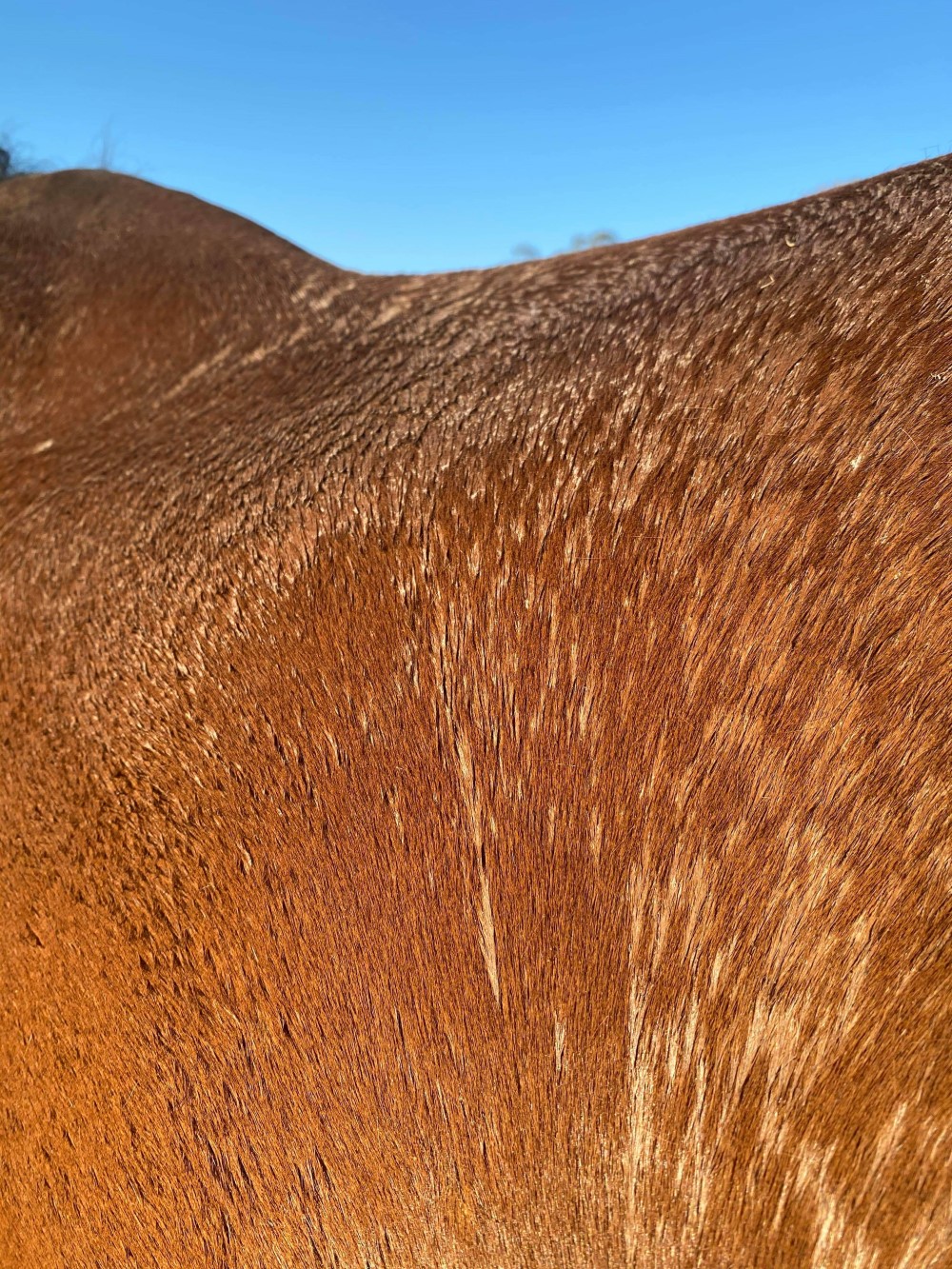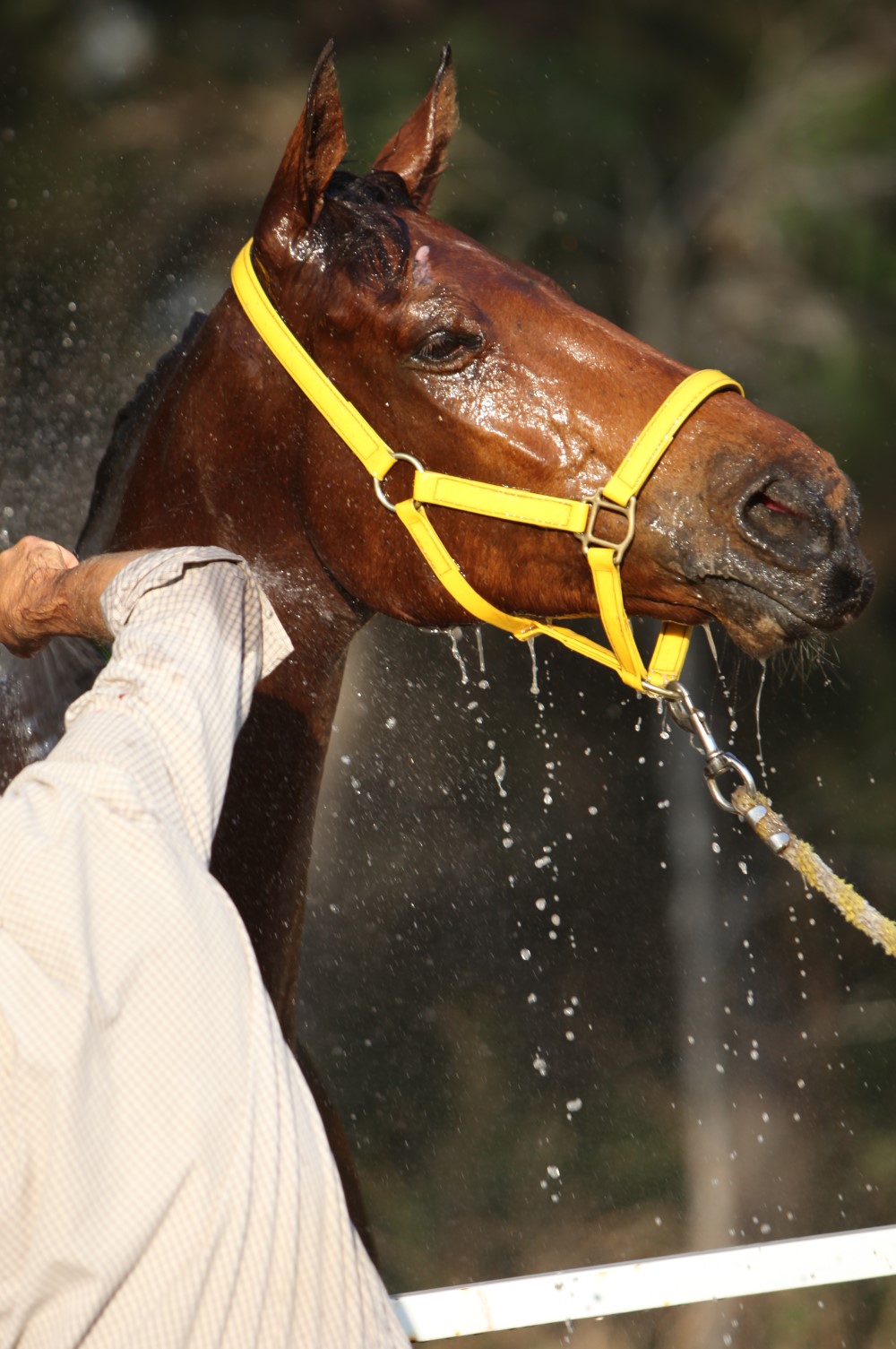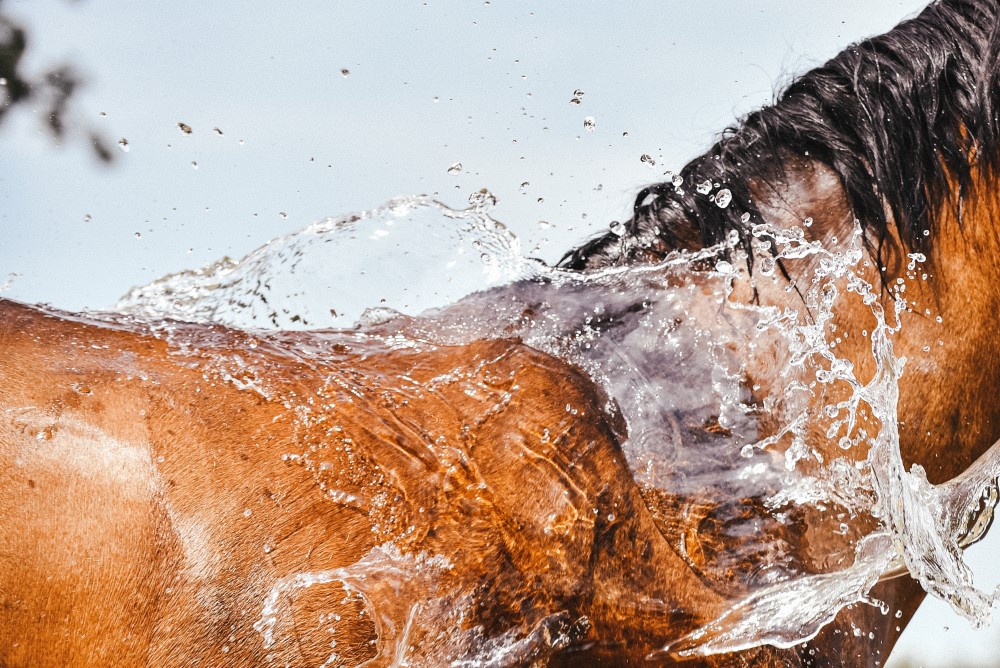Anhidrosis is the medical term for total or partial loss of the ability to sweat normally when stimulated. Why this occurs has not been completely determined, but it is thought to be associated with over-stimulation of the sweat glands, resulting in these glands becoming “desensitised” or unresponsive when stimulated.
Anhidrosis should not be confused with heat stress. Heat stress occurs when the ambient temperature is too hot, or the horse is exercised in humid conditions and cannot lose heat to the environment quickly enough to return its core temperature to normal so the cells in the body can function properly. Heat stress can occur in normal horses that sweat sufficiently when the high temperatures or humidity in the air prevent the sweat being removed; this means the heat is not removed. Anhidrosis and heat stress, however, are often associated with each other as anhidrosis will cause heat stress if management practices are not put into action when required.
There is no specific breed associated with anhidrosis, and many different breeds of horse have been affected, however, Thoroughbreds have been more frequently reported with the condition. This is potentially due to Thoroughbreds more commonly being transported from cooler climates to hot, humid climates, exacerbating the signs of anhidrosis and therefore they are investigated more frequently. There has been evidence to suggest that anhidrosis has a genetic component as some families of horses have had a higher incidence, however, there still needs to be more research done to determine the heritability of this ailment. There has been no sex, age or coat colour identified as a higher risk, however, anecdotally some claims have been made to suggest dark coat-coloured horses are more at risk.

The predominant sweat gland in horses is the apocrine sweat gland, with horses having a little over 800 glands per square centimetre of skin. These sweat glands have a duct that opens into a hair follicle and releases sweat via the follicle. These differ from eccrine sweat glands that open directly onto the skin surface and are the predominant sweat glands in humans. Apocrine sweat glands can be stimulated to release sweat in two ways; one is by the release of adrenaline from the adrenal gland and the other is more complex and requires, in part, direct neural stimulation of the sweat gland (sudomotor function).
Sweat plays a major role in thermoregulation in the horse, with 60-70% of heat loss occurring via sweating. This means that horses with anhidrosis don’t have the ability to lose heat through their skin and need to rely on losing heat through the respiratory system. For this reason, horses that suffer anhidrosis have high respiratory rates (tachypnea) as the body tries to dissipate the generated heat out through the lungs. Anhidrotic horses are typically identified in hot and humid climates, as these environments are going to exacerbate the clinical signs. Horses have been identified as suffering with anhidrosis in cooler climates, but because horses are less clinically affected, they are harder to recognise as the body can thermoregulate easier (lower ambient temperature allows the heat a horse produces to dissipate quicker).
THE CLASSIC CASE
The classic case of anhidrosis is seen when a horse is introduced into a hot climate from a much cooler environment and soon after develops symptoms. This is referred to as acute anhidrosis. The clinical effects are especially evident when asked to exercise in warmer conditions that they haven’t been previously acclimatised to. Initially these horses may be observed to sweat profusely but then show little or no sweating. This is why the suspected initiator of anhidrosis is thought to be an over-stimulation of the sweat glands. Some anhidrotic horses can maintain the ability to sweat in certain regions, such as under the mane, in the relatively hairless region under the arms (axilla), in the groin (inguinal region) and around the anus/vulva/scrotum (perineum). It can also occur under tack sites (saddle and halter). Therefore, it should be noted that the presence of a small amount of sweat in these areas does not negate a diagnosis of anhidrosis.
“Sweat plays a major
role in thermoregulation
in the horse.”

“A definitive diagnosis
usually requires a skin biopsy
or intradermal skin testing.”
Horses that suffer with failure to sweat over long periods can develop long-term changes to the body, particularly their skin, and this is known as chronic anhidrosis. In these horses, the skin becomes dry and flaky, and hair can be lost from areas of the body. This hair loss or alopecia generally occurs around the face and neck.
Other clinical signs seen with anhidrosis include a decrease (acute anhidrosis) or increase (chronic anhidrosis) in their water intake, mild anorexia, poor performance and loss of interest in their surroundings (lethargy). Following work, affected horses will show elevated body temperatures that are slow to return to the normal range. Usually, after exercise a horse’s core temp will rise but should return to normal (37.5-38.3°C) within 30 minutes. A body temperature over 38.5°C after 30 minutes supports the clinical picture of anhidrosis, however, it is not pathognomonic for this condition as there are other causes of prolonged elevated temperatures after a horse has exercised, such as pain and infection.
A presumptive diagnosis of anhidrosis can be made based on clinical symptoms and a history of a change of location to a hotter, more humid climate, but a definitive diagnosis usually requires a skin biopsy or intradermal skin testing. This latter test involves a series of injections into the skin of a drug (terbutaline sulphate or salbutamol sulphate are examples) prepared at varying dilutions, that are designed to stimulate sweating in normal horses. A normal horse will sweat at all dilutions; one with partial anhidrosis may only sweat at sites where lower dilutions of chemical are administered. A horse with total or severe anhidrosis will not sweat at any dilution.
Skin biopsies will show evidence of changes in the thickening of certain structures in the skin and lack of, or reduction in, size of other structures such as the ducts of the sweat glands and the small villi within these ducts. In some cases, the ducts that are present are clogged up with debris, indicating they haven’t been functioning and sweat has not been expressed out to clean any debris from the ducts.
NO PROVEN CURE
There is no medical cure for anhidrosis, although many have been tried, and treatment is based around the management of the horse and its environment. Horses that have suffered with anhidrosis have been known to return to a normal sweating status when relocated to cool climates for extended periods, however they revert to an anhidrotic state when returned to a hot climate. Therefore, anhidrotic horses that really struggle to cope with hot, humid conditions are better relocated indefinitely to cooler climates if this is an option.
When the horse must remain in hot and humid environments, the main priority is to monitor the horse for signs of heat stress and be prepared to jump into action if early signs of heat stress are detected. Simple husbandry measures such as counting the horse’s respiratory rate or taking the temperature immediately after work and again 30 minutes later can alert the owner that the horse is at risk. Any prolonged increases in respiratory rate or temperature should prompt the owner to utilise the appropriate measures to help reduce the body’s temperature (cold hosing, ice, fans etc).

Decreasing the risk of heat stress can be achieved by working the horse in the coolest part of the day (early morning or late evenings) and having the facilities available to be able to cool the horse as soon as its work is finished. This can be done using cold water hoses, buckets of iced water, or mist fans to help wet the coats of the horse so heat can be transferred from the internal core of the horse into the water on the skin and then removed by scraping off the water or evaporating it using a fan. Some horses will relish having access to dams or large water containers they can voluntarily stand in to cool themselves off.
Stables should be fitted with large industrial fans to cool the environment and promote the removal of heat from the horse. If horses are housed outside and there is no option to house them inside out of the heat, adequate shade must be provided. Avoid feeding large amounts of hay as a lot of internal heat is produced when digesting hay (hay is great to feed horses in the winter as it provides a source of heat to keep the horse warm).
“Research continues to find
answers but until a cure is
found, identifying and managing
anhidrosis remains the key.”

Oral electrolytes are commonly recommended to all horses performing in hot climates due to the amount of electrolyte lost in sweat. Some companies, however, claim to have electrolyte products that induce sweating, but these claims have not been proven scientifically and may only reflect this positive effect on horses that are deficient in salts and not true anhidrotic horses. Other reported “treatments” that have been touted as cures but not proven include iodinated casein, tyrosine, levothyroxine, and vitamin E. Drugs designed to decrease the amount of adrenaline that can attach to the receptor sites have also been tried, but similarly no studies to confirm or reject this as a valid treatment have occurred. In all cases, horses should always have free access to plentiful amounts of clean, fresh water.
Research continues to find answers but until a cure is found, identifying and managing anhidrosis remains the key to ensuring our horses can keep working while still continuing to enjoy life. EQ
YOU MIGHT ALSO LIKE TO READ BY DR MAXINE BRAIN:
Fractured Jaws – Equestrian Life, December 2023
Keeping Our Country Free of Disease – Equestrian Life, November 2023
Managing Endometritis – Equestrian Life, October 2023
Granulosa Cell Tumours – Equestrian Life, September 2023
Being a Horse in Africa – Equestrian Life, August 2023
Splint Bone Fractures – Equestrian Life, July 2023
When Horses Choke – Equestrian Life, June 2023
The Challenge of Treating HPSD – Equestrian Life, May 2023
From the Horse’s Mouth: Salivary Glands – Equestrian Life, February 2023
Cardiac Murmurs – Equestrian Life, February 2023
Matters of the Heart – Equestrian Life, January 2023
Umbilical Concerns in Foals – Equestrian Life, December 2022
Retained Foetal Membranes – Equestrian Life, October 2022
Preparing for Laminitis – Equestrian Life, September 2022
Working Together for Best Outcomes – Equestrian Life, August 2022
What Constitutes an Emergency – Equestrian Life, July 2022
Peri-Tarsal Cellulitis Calls for Quick Action – Equestrian Life, June 2022
Sinusitis: Not To Be Sneezed At – Equestrian Life, May 2022
Japanese Encephalitis: No Cause For Alarm – Equestrian Life, April 2022
Hernia Learning Curve – Equestrian Life, March 2022
Osteochondromas: Benign But Irritating – Equestrian Life, February 2022
Don’t Forget the Water – Equestrian Life, January 2022
Understanding Anaesthesia – Equestrian Life, December 2021
A Quick Guide to Castration – Equestrian Life, November 2021
Caring for Mammary Glands – Equestrian Life, October 2021
Sepsis In Foals – Equestrian Life, September 2021
Understanding Tendon Sheath Inflammation – Equestrian Life, August 2021
The Mystery of Equine Shivers – Equestrian Life, July 2021
Heads up for the Big Chill – Equestrian Life, June 2021
The Ridden Horse Pain Ethogram – Equestrian Life, May 2021
The Benefits of Genetic Testing – Equestrian Life, April 2021
Heavy Metal Toxicities – Equestrian Life, March 2021
Euthanasia, the Toughest Decision – Equestrian Life, February 2021
How to Beat Heat Stress – Equestrian Life, January 2021
Medicinal Cannabis for Horses – Equestrian Life, December 2020
Foal Diarrhoea Part 2: Infectious Diarrhoea – Equestrian Life, November 2020
Foal Diarrhoea (Don’t Panic!) – Equestrian Life, October 2020
Urticaria Calls For Detective Work – Equestrian Life, September 2020
Winter’s Scourge, The Foot Abscess – Equestrian Life, August 2020
Core Strengthening & Balance Exercises – Equestrian Life, July 2020
The Principles of Rehabilitation – Equestrian Life, June 2020
When is Old, Too Old? – Equestrian Life, May 2020

